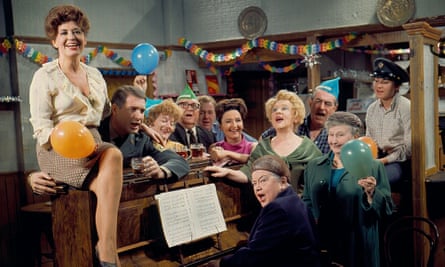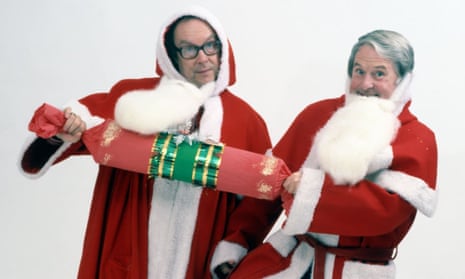How has the experience of Christmas changed for the British over the past century? Despite the blurry photographs in this book, which make the Britain of the 1950s or 20s look impossibly distant, Martin Johnes’s method of research has the effect of making it seem a remarkably stable festival. Johnes has undertaken a great deal of reading, especially of old newspapers, but also of memoirs and novels and diaries, and has evidently compiled some equivalent of a card index to important topics. The book is a gathering together of what he has found, with little attention to chronology. There are sections on consumerism, the family, rituals, religion and so on.
In a typical paragraph, Rider Haggard’s splenetic diary entry from Christmas Day 1920 complaining of a world “flaming with every sort of wickedness” sits alongside loud protests from the Daily Worker in 1935 against ruling-class hypocrisy at Christmas, as well as a 1981 article by Auberon Waugh arguing that over-generous presents for children prepared them to become members of a society that expected government handouts. All these must have come from the section under “B” for “Bah! Humbug!” in his index.

His authorities are either admirably wide-ranging or oddly assorted, depending on your viewpoint. Hilda Ogden in Coronation Street is quoted several times, as if this fictional character were a good representative of the attitudes of her times. Reflecting on the apparent increase in murders and domestic violence during the festive season, he refers to Agatha Christie’s Poirot on the strains for the English of appearing “amiable” at Christmas. In fact, he uses novels a good deal, quoting characters or sardonic narrators as if they appeared in the records of Mass Observation.
Among his favoured sources are the memoirs of politicians, enabling us to know that Paddy Ashdown comes over quite religious when he goes to midnight mass in a rural church, while Tony Benn was quite happy to use Christmas Day to conspire on the phone with Ken Livingstone about his choice of running mate for the London mayoral elections. As a “future Conservative MP”, Gyles Brandreth’s views on present-giving are quoted with due seriousness.
Do any of these examples or quotations tell us anything? As Johnes notes, “People who claimed to dislike it could still enjoy Christmas, while others who went along with the festivities might dislike them deep down.” Just so. He quotes Roy Strong complaining about “ghastly” Christmas cards and “nauseating” decorations – but Google “Roy Strong Christmas” and there he is, a few weeks ago, opening a charity Christmas card shop in Hereford, suitably festooned with decorations. It is true that Kenneth Williams recorded in his diary “all my loathing of Christmas” and liked to spend Christmas morning washing his venetian blinds, but he was a misanthrope. As our author wisely observes: “The historian is faced with a surfeit of published complaints about the festival.”
Occasionally, behind the quotes and anecdotes, we can glimpse customs changing. We see, for instance, that rural communities took part in mummers’ plays up to the 1950s (though Johnes points out that this may have been thanks to the postwar efforts of folk revivalists). The circuits of local bands and choirs that Thomas Hardy depicted in Under the Greenwood Tree persisted into the late 20th century, but the last two decades have seen “the near disappearance of a ritual that connected people to their communities”. You can hear the author’s regret. Yet though Johnes supposes that nostalgia for a traditional Christmas is a condition of “post-industrial societies”, much of his evidence shows that this nostalgia has been a constant for the past century. Nowadays it is the middle aged waxing nostalgic for a time when millions simultaneously watched Top of the Pops or Morecambe and Wise.
There are many intriguing little examples of how Christmas was different in the past. In ITV’s first two years of broadcasting, 1955 and 1956, the channel felt obliged to have religious programmes at peak viewing time on Christmas Day. In 1960, the second year of the televised royal broadcast, the Queen’s speech could be seen or heard at four different times throughout the day. No excuse to miss it. The prominence of children has not always been natural. In 1966 there was a children’s competition to design Christmas stamps – the first year in which the Royal Mail issued these – drawing protests from philatelists who felt that it demeaned the art of stamp design.

The sociological insights offered by this history are hardly arresting. Johnes’s account is aware of the different roles given to men and women, yet its ruminations too rarely transcend the utterly obvious. “Some men could also be prone to find Christmas rather difficult, perhaps because of how different it was to their normal routines.” The big change, mentioned over and over again, yet never exactly traced, is the rise in living standards and expectations among the working classes in the 1950s and 60s. The extraordinary volume of Christmas aftershave sales at the end of the 60s is neatly used as a measure of this spreading sense of affluence. Johnes wonders whether the recent habit of festooning your house with external Christmas lights, flashing blazons and glowing characters is a gesture of joyous proletarian wastefulness.
He surveys his jumble of testimonies and examples, and decides that “most people do seem to have enjoyed Christmas. The festival made people happy and that matters.” With its 50‑odd pages of endnotes, its huge paragraphs and ready sprinkling of statistics, this book may look like an academic study. Yet it yearns to be something else, a kind of intellectually respectable celebration of Christmas. It is a book about how the festival “unites people and turns them from individuals into a community”. The reformed Scrooge would have purred.

Comments (…)
Sign in or create your Guardian account to join the discussion